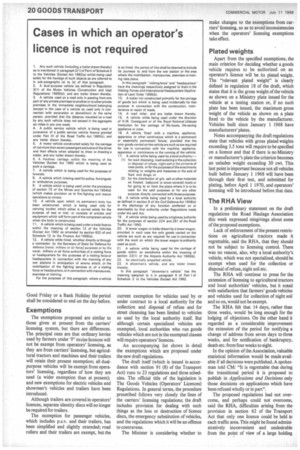Cases in which an operator's licence is not required
Page 22

If you've noticed an error in this article please click here to report it so we can fix it.
1. Any such vehicle (including a trailer drawn thereby) as is mentioned in paragraph 2(1 (of Part I of Schedule 3 to the Vehicles (Excise) Act 1962(a) whilst being used solely for the haulage of such objects as are referred to in sub-paragraphs (a) to (e) of that paragraph.
2. A dual-purpose vehicle (as defined in Regulation 3(11 of the Motor Vehicles (Construction and Use) Regulations 1969(b)). and any trailer drawn thereby.
3. A vehicle used on a road only in passing from one part of any private premises to another or to other private premises in the immediate neighbourhood belonging (except in the case of a vehicle so used only in connection with excavation or demolition) to the same person, provided that the distance travelled an a road by any such vehicle does not exceed in the aggregate six miles in any one week.
4. A public service vehicle which is being used in pursuance of a public service vehicle licence granted under Part III of the Road Traffic Act 1960(c), and arty trailer drawn thereby.
5. A motor vehicle constructed solely for the carriage of not more than seven passengers exclusive of the driver and their effects when adapted to draw or drawing a trailer, and any trailer drawn thereby.
6. A Hackney carriage within the meaning of the Vehicles (Excise) Act 1962 which is being used as such a carriage.
7. A vehicle which is being used for the purposes of funerals.
8. A vehicle which is being used for police. fire brigade or ambulance purposes.
9. A vehicle which is being used under the provisions of section 72 of the Mines and Quarries Act 1954(d) (which makes provision as to fire-fighting and rescue operations at mines).
10. A vehicle upon which no permanent body has been constructed, which is being used only for carrying burden which either is carried solely for the purpose of test or trial, or consists of articles and equipment which will form part of the completed vehicle when the body is constructed.
1. A vehicle which is being used under a trade licence within the meaning of section 12 of the Vehicles (Excise) Act 1962 as amended by section 6(21 of and Schedule 12 to the Finance Act 19691a), 12. A vehicle while hired, whether directly or through a contractor, by the Secretary of State for Defence for defence !naval, military or air force) purposes or by the naval, military or air force authorities of a visiting force or headquarters for the purposes of a visiting force or headquarters in connection with the manning of any war stations in anticipation of enemy attack, or the mobilisation of the fighting services or of a visiting force or headquarters. or in connection with manoeuvres, exercises or training.
For the purposes of this paragraph, where a vehicle is so hired, the period of hire shall be deemed to include its journeys to and from the war station or the area where the mobilisation, manoeuvres, exercises or training take place.
In this paragraph "visiting force" and "headquartershave the meanings respectively assigned to them in the Visiting Forces and International Headquarters lApplication of Law) Order 1965(b),
13. A trailer not constructed primarily for the carriage of goods but which is being used incidentally for that purpose in connection with the construction, maintenance or repair of roads.
14. A road roller, and any trailer drawn thereby.
15. A vehicle while being used under the direction of H.M. Coastguard or of the Royal National Lifeboat Institution for the carriage of life-boats, life-saving appliance or crew.
16. A vehicle fitted with a machine, appliance, apparatus or other contrivance which is a permanent or essentially permanent fixture, provided that the only goods carried on the vehicle are such as are required for use in connection with the machine, appliance. apparatus or contrivance or the running of the vehicle.
17. A vehicle while being used by a local authority— Ill for road cleansing, road watering orthe collection or disposal of refuse. night-soil or the contents of cess-pools, orfor the purposes of the enactments relating to weights and measures or the sale of food and drugs; or (2) for the distribution of grit, salt or other materials on frosted, icebound or snow-covered roads or for going to or from the place where it is to be used for the said purposes or for any other purpose directly connected with those purposes.
18. A vehicle while being used by a local authority as defined in section 9 of the Civil Defence Act 1948(a) in the discharge of any function conferred on or exercisable by that authority under Regulations made under the said Act.
19. A vehicle while being used by a highway authority for the purposes of section 224 and 261 of the Road Traffic Act 1960, 20. A tower wagon or trailer drawn by a tower wagon, provided in each case the only goods carried on the vehicle are such as are required for use in connection with the work on which the tower wagon is ordinarily used as such.
21. A vehicle while being used for the carriage of goods within an aerodrome within the meaning of Section MU of the Airports Authority ACE 1965(b).
22. An electrically propelled vehicle.
23. A showman's vehicle, and any trailer drawn thereby.
In this paragraph -showman's vehiclehas the meaning assigned to it in paragraph 6 of Part I of Schedule 3 to the Vehicles (Excise) Act 1962.












































































































